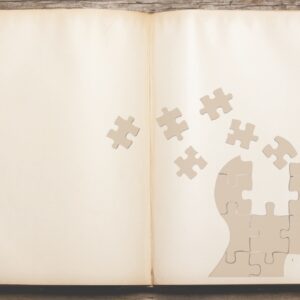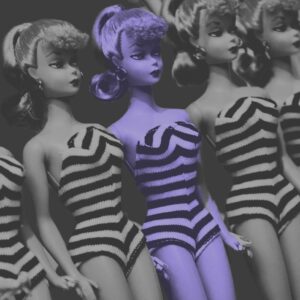
New Poetry by Indigenous Women
A Series Curated by Natalie Diaz
In my Mojave culture, many of our songs are maps, but not in the sense of an American map. Mojave song-maps do not draw borders or boundaries, do not say this is knowable, or defined, or mine. Instead our maps use language to tell about our movements and wonderings (not wanderings) across a space, naming what has happened along the way while also compelling us toward what is waiting to be discovered, where we might go and who we might meet or become along the way.
This feature of indigenous women is meant to be like those song-maps, to offer myriad ways of “poetic” and linguistic experience—a journeys through or across memory, or imagination, across pain or joy or the impossibility of each, across our bodies of land and water and flesh and ink—an ever-shifting, ever-returning, ever-realizing map of movement, of discovery, of possibility, of risk—of indigenous and native poetry. It is my luck to welcome you to this indigenous space and invite you into the conversations of these poems, languages, imageries and wonders. In this installment of the bi-monthly feature, I’m pleased to share the work of Abigail Chabitnoy, Tria Blu Wakpa, Heather Cahoon, and Sara Marie Ortiz (full bios below).
–’Ahotk, Natalie Diaz
*
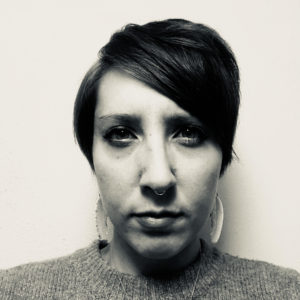
Abigail Chabitnoy
ANATOMY OF A WAVE
It had everything and nothing to do
with mettle
fire before flint before
How many bodies will a lead ball move
through?
How many men can one stand in a row?
When the tide went out, they had nowhere to run
but that was many years ago, and if they have not died they live
happily still.
But you and I know that’s not how the story goes.
I wake more ghosts each morning:
when I was born my mother and father
planted a tree west of the garden.
We ripped it out when I left home—
its roots never took,
its limbs harbored mold in the sticky east wind.
We used to think a weak spine
was inherited
but consider the shark
how some will stop swimming
in their sleep.
How does the forecast change?
We make weather with our teeth.
Why should I be afraid of the sea?
Let the toothed skin lie
if it asks too many bones.
Wait for the waves
to start skipping,
Tie down the drifters and stretch the stomach before the fall.
Don’t turn your back on the water.
What else grows on an island
without trees?
The need to make
makes body—
Others have seen water act this way before,
it was many years ago,
how many bodies a single wave can carry,
how many relatives, casually.
They tied their boats to the tops of trees
so the water wouldn’t lose them,
so the story goes.
Some say it was a boat that killed them, Vasiley and Akelina. Bad heart, traumatized. Accidently.
I’m telling you what happens. Nikifor missed the boat.
Imagine what it might be like
when the waters come
to be a fish
to be twelve strong, to be six, two hundred, or forty
sharks swimming toward you—
IN THE CURRENT WHERE DROWNING IS BEAUTIFUL
White breaks first, waves
green, then black
shining seas ships sailing
not sailing:
what is still
wanting wind.
It used to be no man could go against,
this weather too will pass. The wind
is not a river.
And if a puddle at the last
gives way
to desert:
corked bottle
walled city
veiled woman,
Persephone, were you afraid?
Carwaq tukniuq.
If air the conscious element—
sometimes breath
sometimes bird—
the last few days have been windy, but
The current is strong, Nikifor,
and it rains all the time.
Tamiinek taangaq aturtapet,
and sometimes
if I were not afraid,
I am a fish
with teeth
after all.
![]()
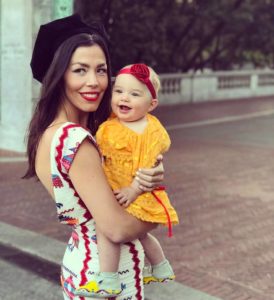
Tria Blu Wakpa
Butterflies, Bones, Languages
I want to know who pierced the Magellan butterfly,
spread its delicately veined wings
and sealed the glass case
sold to an American expat
in the Filipiniana section
of the Landmark Department Store.
Butterflies, bones, languages:
do not label beautiful what you cannot understand.
Sometimes nostalgia masks supremacy.
I want to say that life confined and displayed
is no life at all.
That is and is not true:
ask the Indigenous, the imprisoned, the half-crazed
lion I once saw pacing its cage
at the San Diego Zoo.
When we cannot contain our fear,
we try to control its source.
I am thinking now of survival:
the skillful hands of Igorot girls
coerced to stitch Irish lace
and the adroit tongue of my grandmother
in the primary school
as she learned to speak English
and later Japanese
and my grandmother’s grandmother
as she learned to speak Spanish
and later English.
It is important that I tell you all this
in Tagalog.
But I’m afraid
I don’t know how.
The Politics of Love and The Politics of Blood
Kamama, a Cherokee word,
meaning both butterfly and elephant.
Once a Russian writer said to me,
There are so many bloods
running inside you.
Kamama.
A woman asked my lover,
Are you getting some third world love?
Kamama.
Our ancestor said, I would slit my veins
to bleed out every drop of Indian blood.
Kamama.
How to sort the stories, the silences,
the disavowal and the reclamation of blood?
The politics of passing and the politics of love?
So often we are tempted to flitter for the margins.
Yet the elephant in the room best arises
when we situate ourselves squarely in the center.
The body is the metaphor.
And the metaphor is the body.
Sometimes the body wields the weapon.
Sometimes the weapon is the body.
Emerging from the cocoon of familial story,
with wings still wet
to Native narratives informing
two generations of love stories.
But the truth is that sometimes Indianness
is synonymous with romance.
The truth is that some blood bears
the burden of proof.
Should we interrogate elders?
Dissect identities?
Demand a document that certifies
the measurements of memory
correspond with the measurements of blood?
Perhaps it is as the colonizers intended:
settler-skin crawling in submission
searching their documents for recognition,
deluding blood diluting love.
When are the politics of identification
detrimental to the Nation?
Some days I am Native enough.
Some days I want to give up.
Fluttering from the white hot flame,
often we find ourselves pinned
with as much ferocity as Prufrock,
and he wasn’t even Indian.
![]()
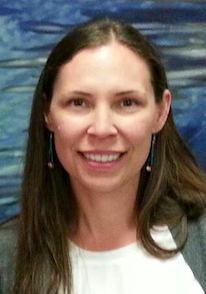
Heather Cahoon
Rebirth and the Almost Moon
Trace it back, movement along jagged horizon, to the time Coyote and Antelope sent their sons to steal the night sun. But the moon was the favorite plaything of a certain tribe of animal people and they were not about to let it go without a fight. However, Coyote’s sons were cunning, capturing the moon. Outsmarted owners in close pursuit they raced through forest across plain until Coyote’s sons began to tire; thus, stretch of ankle met mouth, trip to fatal fall of teeth and bone. As heartbeats slowed they tossed the moon to the Antelope brothers and the chase continued. Antelope’s sons ran like lightning and made it home. Upon presenting their father and Snč̇ĺép[*] with the moon prize and the story of Coyote’s sons’ death, Coyote bent hollow-mouthed howl crying as only a father can. He took the moon back to its owners to make a deal: he would return the moon if they would return his sons to life. They agreed and one by one, Coyote’s sons’ hearts resumed beating, chests rise-falling, wrists pulsing, until their amber eyes blinked on like stars.
[*]Snč̇ĺép = Coyote
Nunxʷé (Believe)
Why this repeated sunburst
of feathered
bodies
cliff
swallow flocks
erupting
into a sky
of lungs
and throat
a thousand
dull
brown wings
frantically
folding
releasing
diffusing
light
refracting
reason
centrifugal
force(s)
d e c e n t r a l i z i n g
until
the word
is
scrambled
un- rec og ni z able
uncomfortable
to look at
as
this
history
of people (sqélixʷ) and place (šiyulexʷ)
so
difficult
to under-
stand
and to
believe.
![]()
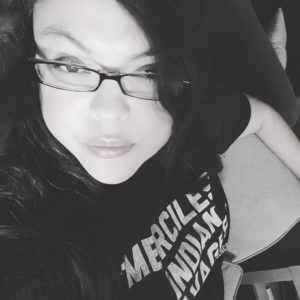
Sara Marie Ortiz
Language
Zer gizon ziren han batailaren amaieran zain? Eta zergatik?
Nephilim? Or dogs? The savagery became them; no matter what we did.
To abate such gnawing. The hearts of lycanthrope
who hovered and moved through the forests
as the ghosts of military men, sons once, lost fathers-all
with gardens of bougainvillea blossoming and withering
in their hearts.
Skinwalker—what song of you now?
Where the wild things are—eat and drink deeply of that,
old heart. They roared their terrible roars. And gnashed their
terrible teeth. . .
Goodnight Moon—four more minutes?
Ebbing into a thousand holy more.
And then ten thousand.
And then the impossibly long nights became
impossibly long and brutal morning;
and the wars had gone on for decades,
and we stopped counting.
Blood in blood out.
Ghost sickness; like all the things they carried—like the things she and
she
and she too
carried. Balm
of Gilead in an old pill box. A delicate white body
of a mantis she’d caught once and wanted to keep alive, but couldn’t.
A dried rose petal plucked from the headstone at Proust’s grave.
La Llorona; this now.
Blown glass
globes of heat and light bobbing
on the surface. A young girl you thought
to be drowning in the Rio Grande; she
wasn’t. Oldest trick in the book. Maybe
you’ll think twice next time when walking
after dark.
Almanac of the dead;
swollen amygdala like a balloon.
Scary Stories to Tell in the Dark;
coffin-length paper lantern from Ikea,
half-lit.
Long slowly dimming dagger
like shaft of light.
Waiting for Godot.
Radishes wrapped in cellophane.
Mi vida loca.
Green gray mold along the cold white of the window pane
(it signals morning and something more sinister than that).
Oldboy.
Blood orange stained cutting board.
A very old man with enormous wings.
Redolent
Symmetry and slow dumb muscle of heart.
Bless me, Ultima.
Shətrəni (Seeds)
We travel.
We wake.
As waves.
As bodies of water, breath, sky, blood-born, land-hewn, urgent, ancient children, yet-rising.
slhémexw
q’ep
kaachani
y’aak’a
insiman
Inaki
qəlb
ʔəsɬaɬlil
Ma xixochi
Rain
to gather
rain
corn
to plant
to be thirsty
{rain}
Live there.
May you sleep.
Prophecy.
The Hanoh (people)
Sacred maps in this, child.
Be as strong as the water, land, stars, and sky made you. The Ancestors, they are here.
![]()
Abigail Chabitnoy earned her MFA in poetry at Colorado State University and was a 2016 Peripheral Poets fellow. Her poems have appeared or are forthcoming in Hayden’s Ferry Review, Boston Review, Tin House, Gulf Coast, Pleiades, Tinderbox Poetry Journal, and Red Ink, among others, and she has written reviews for Colorado Review and the Volta blog. She is a member of the Tangirnaq Native Village in Kodiak, Alaska, grew up in Pennsylvania, and currently resides in Colorado. Her debut poetry collection, How to Dress a Fish, is forthcoming from Wesleyan University Press.
Tria Blu Wakpa is a UC President’s Postdoctoral Fellow in the Department of Dance at UC Riverside and will be an Assistant Professor of Dance Studies in the Department of World Arts and Cultures/Dance at UC Los Angeles in Fall 2018. She earned her Ph.D. and M.A. in Ethnic Studies from UC Berkeley and an M.F.A. in Creative Writing from San Diego State University. Her research and artistic interests are in: Native American education, incarceration, and embodied practice; Indigenous contemporary dance and martial arts; North American Hand Talk (sign language); Native American literature and theory; and creative writing. Blu Wakpa has received major fellowships from the Ford Foundation and Fulbright. She has taught a wide range of interdisciplinary and community-engaged courses at public, private, tribal, and carceral institutions. Blu Wakpa is of Filipina, European, and tribally-unenrolled Native American ancestries. She is married to Dr. Makha Blu Wakpa (Cheyenne River Sioux) and is the mother of their two children.
Heather Cahoon received her MFA in Poetry from the University of Montana where she was the Richard Hugo Memorial Scholar. She won the 2005 Merriam Frontier Award for publication of her chapbook, Elk Thirst, and was awarded a Montana Arts Council Artist Innovation Award in 2015 to support the completion of her book-length manuscript entitled, Horselfy Dress. Her writing has appeared in numerous publications including Hanging Loose, South Dakota Review, New Poets of the American West, and Poems Across the Big Sky: An Anthology of Montana Poets. Heather also holds an interdisciplinary PhD in history, anthropology, and Native American Studies. She lives in Missoula, Montana and works as policy analyst, poet and artist. Heather is from the Flathead Indian Reservation in western Montana and is a member of the Confederated Salish and Kootenai Tribes.
Sara Marie Ortiz (Pueblo of Acoma) is a graduate of the Institute of American Indian Arts and Antioch University Los Angeles’ Creative Writing MFA program with a focus in creative nonfiction. She’s formally studied law, Indigenous education, global self-determination in Indigenous communities, journalism, theater, critical theory, and film at the University of New Mexico, the University of South Dakota, Haskell Indian Nations University, the Institute of American Indian Arts and has worked for many years in Native arts, culture, and education throughout New Mexico, the Pacific Northwest, throughout Indian Country and abroad, and has been writing and publishing widely from the age of eighteen. Her first collection of poetry and nonfiction Red Milk was published in 2013 and she is currently at work on her second collection called Savage: A Love Story. Sara Marie lives in Seattle, Washington and is currently the Native Education Program Manager for Highline Public Schools.











